Practical Process Research and Development – A guide for Organic Chemists: Practical Process Research and Development – A guide for Organic Chemists
Autor Neal G. Andersonen Limba Engleză Paperback – 15 apr 2012
Second Edition highlights:
• Reflects the current thinking in chemical process R&D for small molecules
• Retains similar structure and orientation to the first edition.
• Contains approx. 85% new material
• Primarily new examples (work-up and prospective considerations for pilot plant and manufacturing scale-up)
• Some new/expanded topics (e.g. green chemistry, genotoxins, enzymatic processes)
• Replaces the first edition, although the first edition contains useful older examples that readers may refer to
- Provides insights into generating rugged, practical, cost-effective processes for the chemical preparation of "small molecules"
- Breaks down process optimization into route, reagent and solvent selection, development of reaction conditions, workup, crystallizations and more
- Presents guidelines for implementing and troubleshooting processes
Preț: 561.36 lei
Preț vechi: 616.88 lei
-9% Nou
Puncte Express: 842
Preț estimativ în valută:
107.42€ • 112.38$ • 89.23£
107.42€ • 112.38$ • 89.23£
Carte tipărită la comandă
Livrare economică 26 martie-09 aprilie
Preluare comenzi: 021 569.72.76
Specificații
ISBN-13: 9781493301256
ISBN-10: 149330125X
Pagini: 486
Dimensiuni: 152 x 229 mm
Greutate: 0.75 kg
Ediția:2
Editura: ELSEVIER SCIENCE
ISBN-10: 149330125X
Pagini: 486
Dimensiuni: 152 x 229 mm
Greutate: 0.75 kg
Ediția:2
Editura: ELSEVIER SCIENCE
Public țintă
Industrial (primarily organic) chemists, and academicians (particularly those involved in a growing number of start-up companies) and students who need insight into industrial process R&D.Cuprins
1. Introduction to the role of process development 2. Process safety3. Route selection 4. Reagent selection5. Solvent selection6. Effects of water7. In-process assays, in-process controls, and specifications8. Practical considerations for scale-up9. Optimizing processes by minimizing impurities10. Optimizing organometallic reactions 11. Workup12. Crystallization and purification13. Final product form and impurities14. Continuous operations 15. Refining the process for simplicity and ruggedness16. Process validation and implementation17. TroubleshootingGlossary and indices: general, reagents, reactions, and drug substances
Recenzii
"This second edition text is at a more advanced level than the original, reflecting the abundant sources of information that have become available in the last ten years and the author’s reconsideration of this presentation. Anderson has worked for 30-plus years in the pharmaceutical industry. His text offers a step-by-step approach, beginning with discussion of how and why operations are carried out and then illustrating principles with examples. Coverage encompasses process safety; route, reagent, and solvent selection; effect of water; in-process assays, controls, and specifications; practical considerations for scale-up; refining the process for simplicity and ruggedness; and troubleshooting, among other topics." --Reference and Research Book News, August 2012
"I would hope that most readers of this journal are very familiar with the first edition of Neal Anderson’s excellent book on Chemical Process Research and Development and are as keen to see the second edition as I was. The good news is that the new edition is bigger (by over 100 pages), better than the original, and cheaper… The big improvement in the new edition is the layout so that the schemes are now much closer to the relevant text than before which makes reading that much easier…Overall this book is highly recommended even if you already have a copy of the original edition." --Organic Process Research and Development
"I would hope that most readers of this journal are very familiar with the first edition of Neal Anderson’s excellent book on Chemical Process Research and Development and are as keen to see the second edition as I was. The good news is that the new edition is bigger (by over 100 pages), better than the original, and cheaper… The big improvement in the new edition is the layout so that the schemes are now much closer to the relevant text than before which makes reading that much easier…Overall this book is highly recommended even if you already have a copy of the original edition." --Organic Process Research and Development
